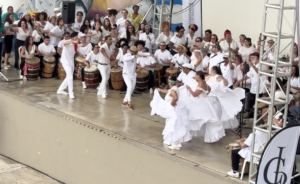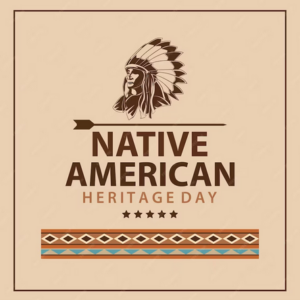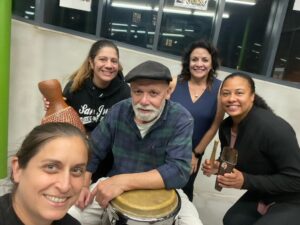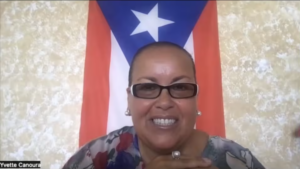by Francisco G. Gómez
At first glance, you may think that Don Luis Soto is just an ordinary man; you may even look at him and not believe he’s a farmer. In fact, he’s a retired agronomist who’s always been a farmer as well. The first time I saw a short made by him on Youtube, I thought the same thing. It was actually that vid that was the catalyst that led me to this extraordinary man and his farm (finca), Mi Casa. Only after meeting Don Luis did I understand that the simplicity of the man is what makes him extraordinary. He looks at life through the lens of the natural world. His unassuming demeanor and sensitivity for all living things creates balance that’s truly organic in every sense of the word. He has a wisdom taught to him by years in contact with the earth; this wisdom must be preserved and passed on.
 Don Luis lives with his wife Doña Carmen in the coastal area of Camuy, Puerto Rico, just 10 minutes away from the ocean. His modest home sits on four and a half acres of organic flat farm land, of which only two acres are dedicated to the most diverse array of trees, vegetables, fruits, nuts, flowers and herbs. The other two and a half acres are left to pasture; his rare breed of bulls take care of mowing the lawn and hay. There’ll be more on the bulls in a while.
Don Luis lives with his wife Doña Carmen in the coastal area of Camuy, Puerto Rico, just 10 minutes away from the ocean. His modest home sits on four and a half acres of organic flat farm land, of which only two acres are dedicated to the most diverse array of trees, vegetables, fruits, nuts, flowers and herbs. The other two and a half acres are left to pasture; his rare breed of bulls take care of mowing the lawn and hay. There’ll be more on the bulls in a while.
We arrived promptly at 9 am, and Don Luis was already outside waiting for us. We began the tour of his farm, and I immediately felt the incredible sense of reverence this soft spoken man has for the earth and all it contains.
 Before arriving at the Turmeric patch he had planted, he had already begun to tell us the scientific name for turmeric (curcuma zedoaria). He explained how the herb had arrived on the island by way of seafarers long ago and that it is a rhizomatous herbaceous perennial belonging to the ginger family. He spoke of its uses as a dye, as a culinary seasoning and as medicine to treat such ailments like indigestion, skin lesions, liver disease and a host of other maladies. He also mentioned its spiritual and religious uses in South Asia; his face lit up as he referred to turmeric as a spiritual plant, something I had not heard spoken that way about before, but simply read. It seemed to me that he was alluding to the need for humans to pray over the plant in order to achieve its full benefits, but that is only speculation on my part! Don Luis seems to me as being a spiritual man, but not a holy man, and yet, it also seems that agriculture is his religion.
Before arriving at the Turmeric patch he had planted, he had already begun to tell us the scientific name for turmeric (curcuma zedoaria). He explained how the herb had arrived on the island by way of seafarers long ago and that it is a rhizomatous herbaceous perennial belonging to the ginger family. He spoke of its uses as a dye, as a culinary seasoning and as medicine to treat such ailments like indigestion, skin lesions, liver disease and a host of other maladies. He also mentioned its spiritual and religious uses in South Asia; his face lit up as he referred to turmeric as a spiritual plant, something I had not heard spoken that way about before, but simply read. It seemed to me that he was alluding to the need for humans to pray over the plant in order to achieve its full benefits, but that is only speculation on my part! Don Luis seems to me as being a spiritual man, but not a holy man, and yet, it also seems that agriculture is his religion.
 As he spoke about other plants and flowers, we arrived at his compost heap. I love the transformation of compost, so this is of particular interest to me. First off, the heap didn’t have any scent whatsoever. This was very strange because the temperature was well over 85 degrees that day and the sun was brutally oppressive. I believe that’s cause enough to make anything that’s decomposing stink to high heaven. Perhaps you can see the water spigot coming out from the center of the heap in the pic. Don Luis said he waters his compost a few times a week in order to keep the living matter in the heap doing its job of decomposing everything he throws in there. This process, according to him, eliminates the undesirable odors. But then again, there was only leaf and plant matter in his compost heap; we didn’t see any house food or animal manure at all. I believe there’s more to his compost than meets the eye. In any case, I intend to learn more about how he composts in future dialog with him. We’ll keep you posted!
As he spoke about other plants and flowers, we arrived at his compost heap. I love the transformation of compost, so this is of particular interest to me. First off, the heap didn’t have any scent whatsoever. This was very strange because the temperature was well over 85 degrees that day and the sun was brutally oppressive. I believe that’s cause enough to make anything that’s decomposing stink to high heaven. Perhaps you can see the water spigot coming out from the center of the heap in the pic. Don Luis said he waters his compost a few times a week in order to keep the living matter in the heap doing its job of decomposing everything he throws in there. This process, according to him, eliminates the undesirable odors. But then again, there was only leaf and plant matter in his compost heap; we didn’t see any house food or animal manure at all. I believe there’s more to his compost than meets the eye. In any case, I intend to learn more about how he composts in future dialog with him. We’ll keep you posted!
 A few more plant and tree explanations and we were at his sugar cane micro plantation, situated next to his huge green house. Don Luis gave us a brief history class on the unjust sugar industry in Puerto Rico, founded on the subjugation of human beings as beasts of burden. He then explained why he chose this particular type of sugar cane to plant. It turns out that the cane you see in the picture is of a lower sugar content than the traditional sugar cane planted on the island in the 19th and 20th centuries. The original cane
A few more plant and tree explanations and we were at his sugar cane micro plantation, situated next to his huge green house. Don Luis gave us a brief history class on the unjust sugar industry in Puerto Rico, founded on the subjugation of human beings as beasts of burden. He then explained why he chose this particular type of sugar cane to plant. It turns out that the cane you see in the picture is of a lower sugar content than the traditional sugar cane planted on the island in the 19th and 20th centuries. The original cane  underwent a series of evolutionary processes in order to achieve a suitable sugar level and quality.
underwent a series of evolutionary processes in order to achieve a suitable sugar level and quality.
Don Luis cut some of his cane stock for us to sample and understand, first hand, what he had just explained. I must say that what I tasted was far less sweet than any sugar cane I have ever sampled. He explained that this type of sugar  cane, and the modest amount that he was
cane, and the modest amount that he was
growing, surrounded by the diversity of other flora
planted in its vicinity, made the cane very strong and taste the way it does. He informed us that mono culture growing would never produce such tasty cane and that this was no secret at all; it’s simply a balance in just one of the many aspects of Nature, as he put it!
 Next, we entered his enormous green house where he had planted hot weather tolerant tomatoes and lettuce. There were also a variety of herbs, eucalyptus, lavenders, lemon grasses, thymes, parsleys, as well as, other herbs too numerous to include here. As we headed out of the green house, immediately to the right, we noticed the biggest eggplant bushes we had ever seen. They were taller than Nicky! Don Luis told us that the bushes were of a type that fare very well in the tropics; by their size this could not be denied.
Next, we entered his enormous green house where he had planted hot weather tolerant tomatoes and lettuce. There were also a variety of herbs, eucalyptus, lavenders, lemon grasses, thymes, parsleys, as well as, other herbs too numerous to include here. As we headed out of the green house, immediately to the right, we noticed the biggest eggplant bushes we had ever seen. They were taller than Nicky! Don Luis told us that the bushes were of a type that fare very well in the tropics; by their size this could not be denied.
 Moving along past the eggplants we came upon two beautiful types of Passion Fruit (parcha – passiflora edulis). The first was both yellow on the outside and inside; Don Luis split it open and let us sample it. It was deliciously bitter and filled with many seeds. The second was yellow on the outside and red on the inside; it also had many seeds on the inside; however, it was bitter sweet; I really enjoyed this variety the most. Doña Carmen approached us at this point and Don Luis handed her a bunch of the fruit, and shorty thereafter she disappeared to make us fresh juice that we would savor at lunchtime.
Moving along past the eggplants we came upon two beautiful types of Passion Fruit (parcha – passiflora edulis). The first was both yellow on the outside and inside; Don Luis split it open and let us sample it. It was deliciously bitter and filled with many seeds. The second was yellow on the outside and red on the inside; it also had many seeds on the inside; however, it was bitter sweet; I really enjoyed this variety the most. Doña Carmen approached us at this point and Don Luis handed her a bunch of the fruit, and shorty thereafter she disappeared to make us fresh juice that we would savor at lunchtime.
Coming to the end of our tour, I noticed a horse in the distance and asked Don Luis why he was on the plant side of the farm and not in the pasture, separated from the bulls. He explained that Cariño (Love) was getting used to the terrain where he was grazing because he needed exercise and would be used to plow the remainder of land that was to be utilized for planting. He saw the look of concern on my face and quickly assured me that Cariño would not be overburdened in this work. I also asked him why he had named the horse Cariño and he told me I would soon find out.
 Well, Mr. Ed had nothing on Cariño. He was the friendliest horse I have had the chance to meet. He immediately came towards me and nibbled my arm and then continued to push me with his long snout as we all conversed about the bulls eating hay on the other side of the fence.
Well, Mr. Ed had nothing on Cariño. He was the friendliest horse I have had the chance to meet. He immediately came towards me and nibbled my arm and then continued to push me with his long snout as we all conversed about the bulls eating hay on the other side of the fence.
It turns out that these rare bulls (bueyes criollos) are of a breed that slowly disappeared in the middle part of the 20th century as Puerto Rico moved from an agrarian into an industrial society. Don Luis said he had the opportunity to secure some of these bulls and he decided to increase their numbers again. He explained how these
animals were the backbone of agriculture on the island starting back in the 1930s. I asked him why  and he said they are very strong animals with very short hair and extremely tolerant of the brutal heat of Puerto Rico. I noticed that his bulls were not castrated and asked him why. He said that it was cruel to castrate another living creature; that it took away part of the essence of what makes that creature what it is. I then asked him how he dealt with these bulls when they became ornery; he said they would figure that out themselves. I believe this is a very humane way of dealing with this situation and just another example of Don Luis’ respect for all living things.
and he said they are very strong animals with very short hair and extremely tolerant of the brutal heat of Puerto Rico. I noticed that his bulls were not castrated and asked him why. He said that it was cruel to castrate another living creature; that it took away part of the essence of what makes that creature what it is. I then asked him how he dealt with these bulls when they became ornery; he said they would figure that out themselves. I believe this is a very humane way of dealing with this situation and just another example of Don Luis’ respect for all living things.
 As our tour of the farm came to an end, we headed back to Don Luis’ house for a wonderful lunch of homemade bread, cheese and, of course, the delicious Parcha juice that Doña Carmen had so graciously put together for us. It was the perfect finish to such an amazing morning. It was also the way that hospitality is shared on the island; great organic food, zeitgeist at the table and beautiful people that are now our friends and teachers.
As our tour of the farm came to an end, we headed back to Don Luis’ house for a wonderful lunch of homemade bread, cheese and, of course, the delicious Parcha juice that Doña Carmen had so graciously put together for us. It was the perfect finish to such an amazing morning. It was also the way that hospitality is shared on the island; great organic food, zeitgeist at the table and beautiful people that are now our friends and teachers.
After we finished our delightful lunch, Don Luis showed us his wonderful collection of seeds. He is truly a master agronomist, farmer and keeper of the seed, as well as, a man closely connected to Mother Earth and Source! My last reflections of all that I saw and experienced that day was the fact that these old timers, who know and truly understand the agricultural past, are quickly disappearing; many times without their precious knowledge and wisdom being documented and lost forever when they pass on.
For those of us who do the work of sustainability in addressing the plight of the land and the oceans, it is imperative that we seek out and preserve the repositories of invaluable data that these stewards of the commons possess. Moreover, it is of the utmost importance that we develop a sensitivity, ergo a spirituality, that compliments the application of this age old information. Our very existence depends on it!
Note: If you’re ever in Puerto Rico and you would like to visit Don Luis and see his organic farm Mi Casa, USDA certified by the way, give him a call at 1.787.306.3672. He speaks English for those of you who don’t speak Spanish.



